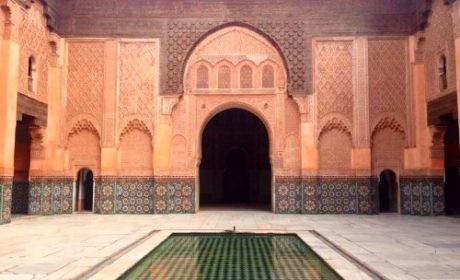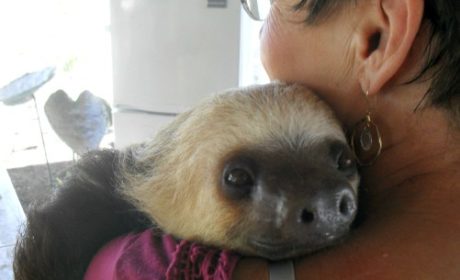Located in Northern Africa, Morocco may seem like an off-the-beaten-path trip, yet it’s only 8.6 miles from Spain! In this Morocco itinerary you’ll discover ways to explore a country that offers a wide variety of travel experiences that boomers will enjoy.
My Itchy Travel Feet featured writer, Debi Lander of ByLanderSea, recently spent two weeks in Morocco. She writes about her experience exploring the best of Morocco. Spoiler alert: after reading this article, you’ll want to visit Morocco, too!
I imagined the Sahara Desert as a flat, endless expanse of sand and Morocco, a country on the northwestern edge of Africa, within its borders. But, as is frequently the case, I was wrong.
During a visit to Morocco, I discovered diverse landscapes: rolling hills similar to Tuscany; immense, jagged snow-topped mountains; emerald date palms growing in oases; and modern, progressive cities full of skyscrapers.
Visiting the best of Morocco, I passed many miles of silvery olive groves, goats in Argan trees, and an entire town painted blue. At each stop, I was warmly welcomed and presented sweet mint tea, a sign of hospitality.
Table of Contents
Morocco Itinerary: 2 weeks exploring the best of Morocco
I traveled with a small group of Americans in a large van. We occasionally had the chance to visit and dine with locals.
These interactions provided an insightful look at their customs and living conditions. My review below covers the highlights of my itinerary for Morocco. It includes destinations that are available to any visitor.
Casablanca: Rick’s Cafe and Hassan II Mosque
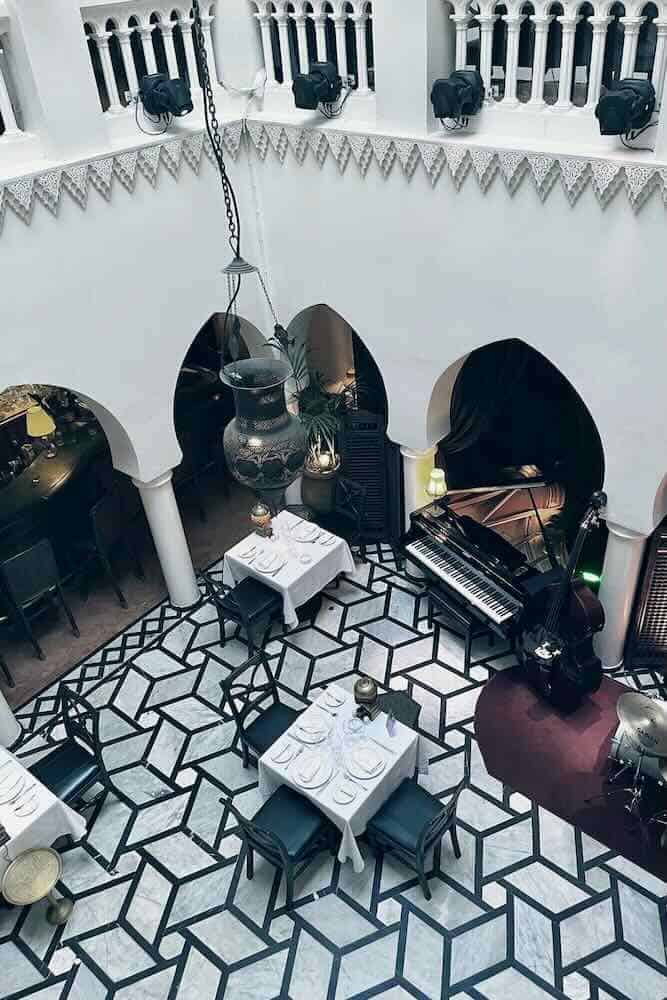
My trip began in Casablanca, Morocco’s business capital. Of course I insisted on visiting Rick’s Café (from the movie Casablanca).
Here’s a bit of movie trivia: the classic film (see it here) was NOT filmed in Morocco. Still, legendary Rick’s bar and restaurant live on, piano player and all. Drinks and dinner make for a memorable night.
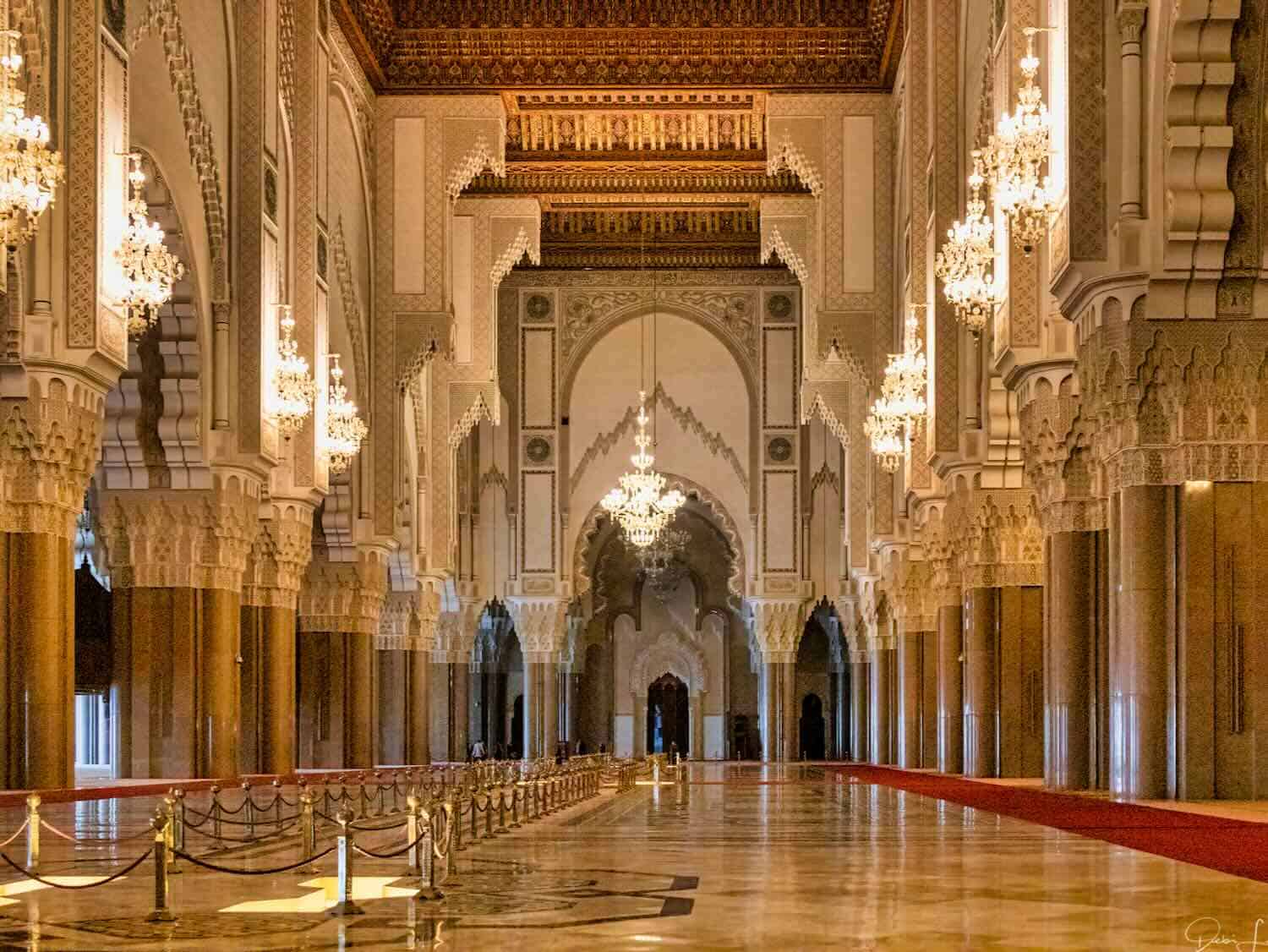
The Hassan II Mosque also calls Casablanca home, the largest and most ornate in the country and the only one open to non-Muslims. The minaret soars to 656-feet, a glass floor hovers over the Atlantic Ocean, the central ceiling slides open, and the prayer hall can hold 25,000 faithful worshippers.
Knowledgeable guides lead group tours (here’s a private tour) explaining the areas and shrines within the immense structure and answering questions about practices of the religion. Don’t miss this opportunity.
Boomer Travel Tip
MedjetAssist Members who are hospitalized 150 miles from home receive medical transport to a home-country hospital of choice. Memberships from $99.
Chefchaouen: the blue city
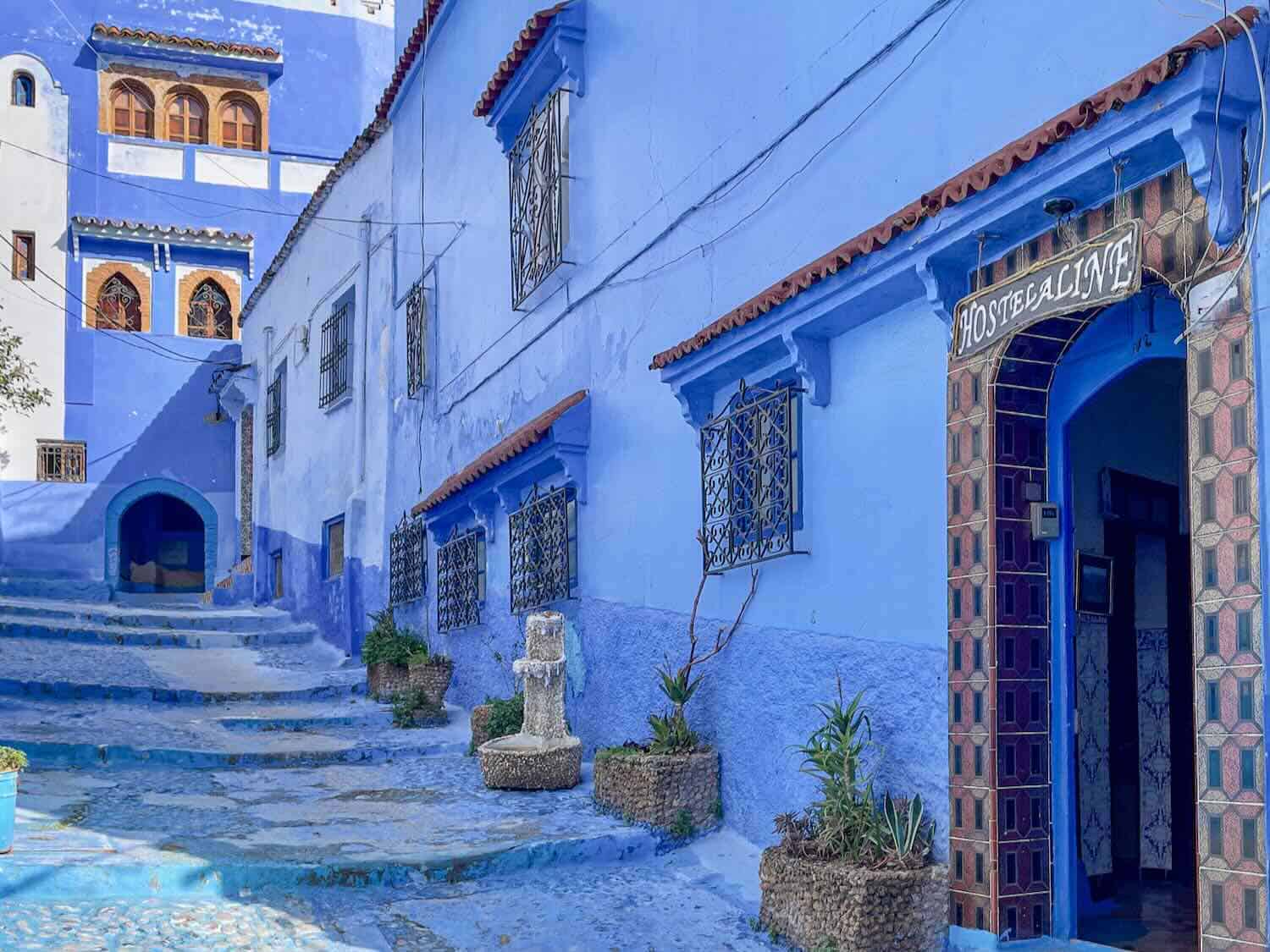
I moved north toward the Rif Mountains and Chefchaouen, the Blue City, or more precisely, the blue on blue city. Houses, walls, walkways, and stairs radiate hues of azure blue, ice blue, electric blue, cobalt blue, cornflower blue, robin’s egg blue, and sometimes accents of white. (Think Santorini, but blue.)
Meander through the inviting warren of winding pathways that rise and fall about the hill town. It’s easy to lose your breath and your way. Fortunately, plenty of shop owners and residents help you with directions.
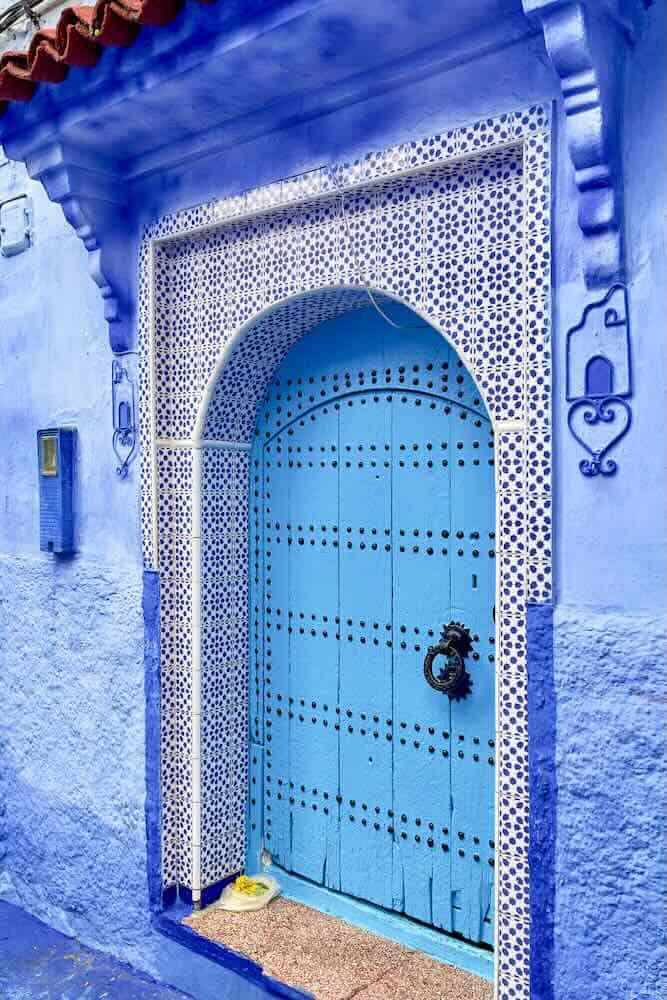
Unfortunately, it was raining when I arrived, but the sun soon returned. Perhaps a blessing, as the soaking provided even more oomph to the palette of blues. Check out the 15th-century earthen Casbah (old fort) in the center of the lower town, and eat in one of the restaurants on the plaza.
The following day, I returned to the magical, narrow streets capturing images of the town coming to life. Many cats and dogs live here, and they look well-fed. This small hilled village, whose name translates to “blue pearl,” presents itself like no other, memorably delightful.
Volubilis: Roman ruins and ancient history

UNESCO World Heritage sites and National Parks never disappoint me, and Morocco’s Volubilis certainly makes a worthwhile stop. We arrived following another downpour, but the rain didn’t prevent van views of the postcard-worthy landscape. The hills compare to scenes of verdant Italy, even Ireland, with gently rolling acres and patchworked farms.
A guided walking tour of Volubilis, a UNESCO World Heritage site, took us past stone foundations, partially restored arches, temples, and some fine mosaic floors strewn around the 99-acre site. Founded in the 3rd-century BC, historians believe it was once home to 20,000 residents.
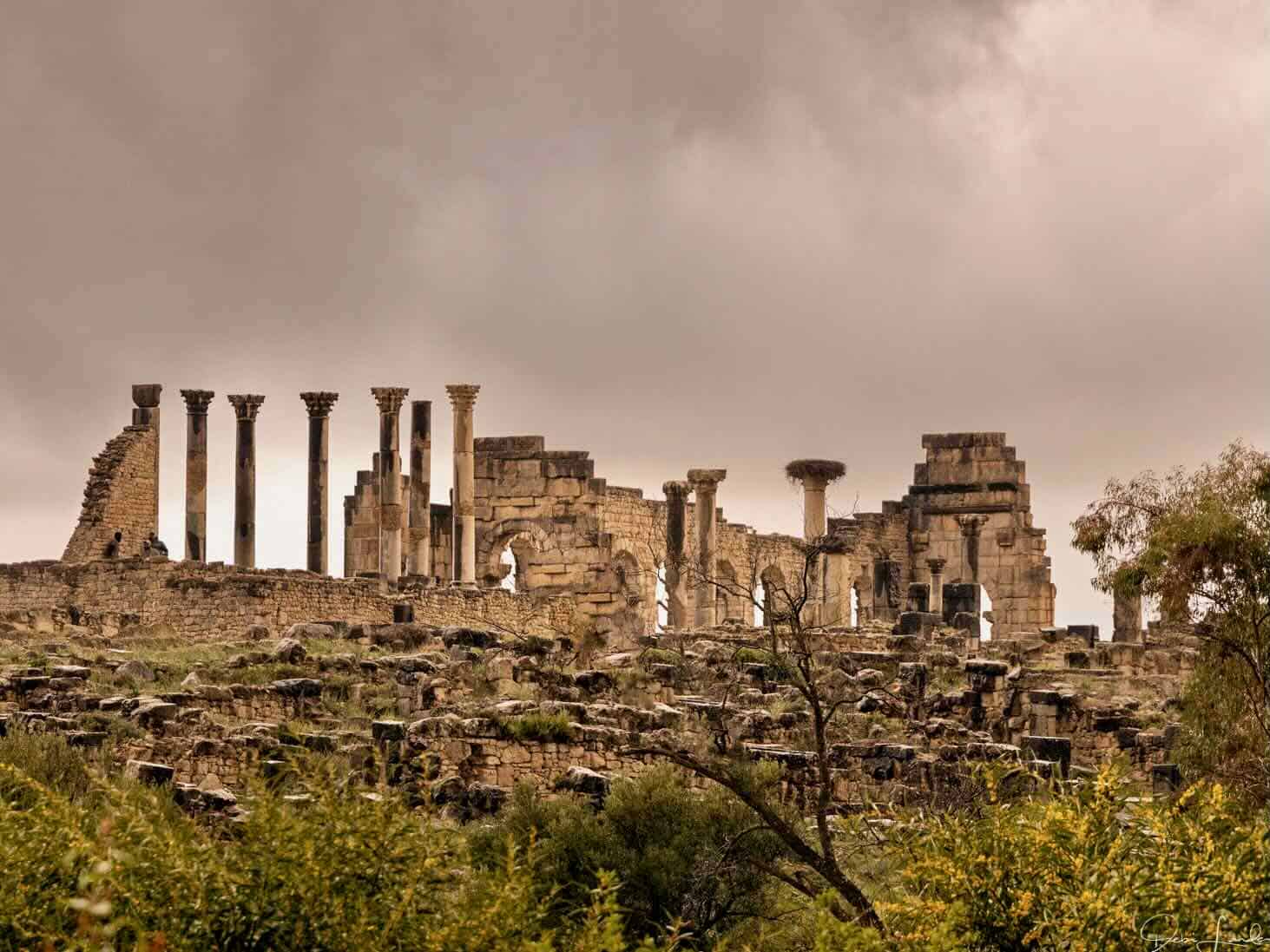
The rocks tell the legacy of the mighty Roman presence in this area. The Roman Empire extended from this southwestern point in Africa, across Asia and Europe, into England.
The ruins naturally resemble those in Rome, Pompei, or Hadrian’s Wall. Still, I was impressed by the mosaics, the foundations of grand houses with heated baths and pools, the triumphal arch, and the imposing basilica. I simply wasn’t expecting Roman ruins in Morocco.
Fes: Morocco’s oldest city
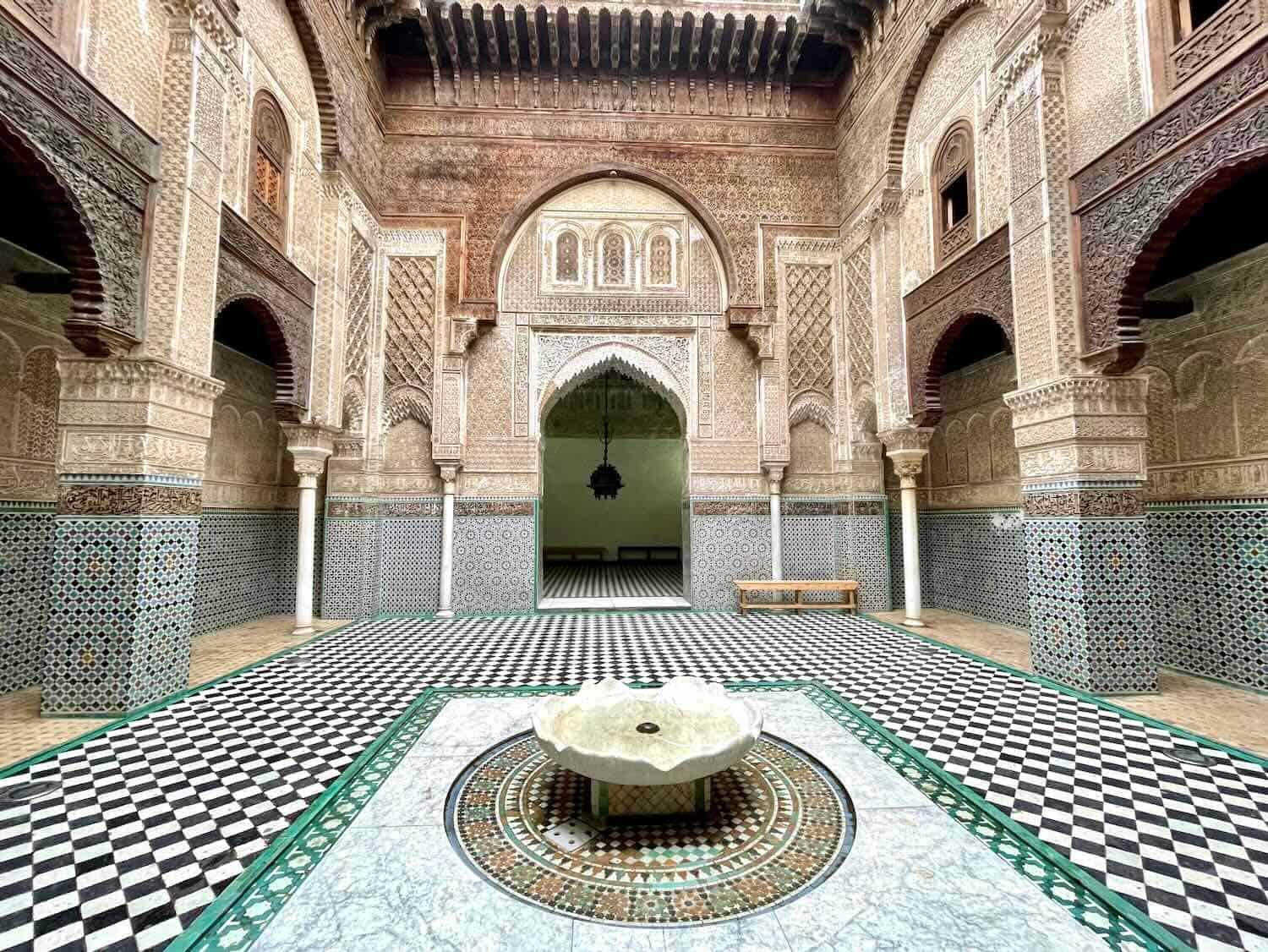
My group moved on to Fes (also referred to as Fez), Morocco’s oldest city, where many professional artisans live and practice their craft. Look for keepsake treasures such as fine ceramic ware, mosaics, copper and tin pieces, loom-woven textiles, handmade rugs, and leather goods. Observe skilled hands at work in their studios, factories, and shops.
I bought a glazed blue and white (colors of Fes) tagine for cooking, a finely-woven scarf, and the popular souvenir, a pouf—an embroidered leather footrest. Boomer travel tip: purchase poufs flat and fill it when you return home.
The medina of Fes, the old walled city, strangles with congestion along narrow single file passageways. You’ll need to dodge and weave through the boggled pedestrian traffic, and make way for the occasional mule and cart. Take in the endless sights, sounds, and smells of butchers, bakers, and even candlestick makers.
The Fes Tannery
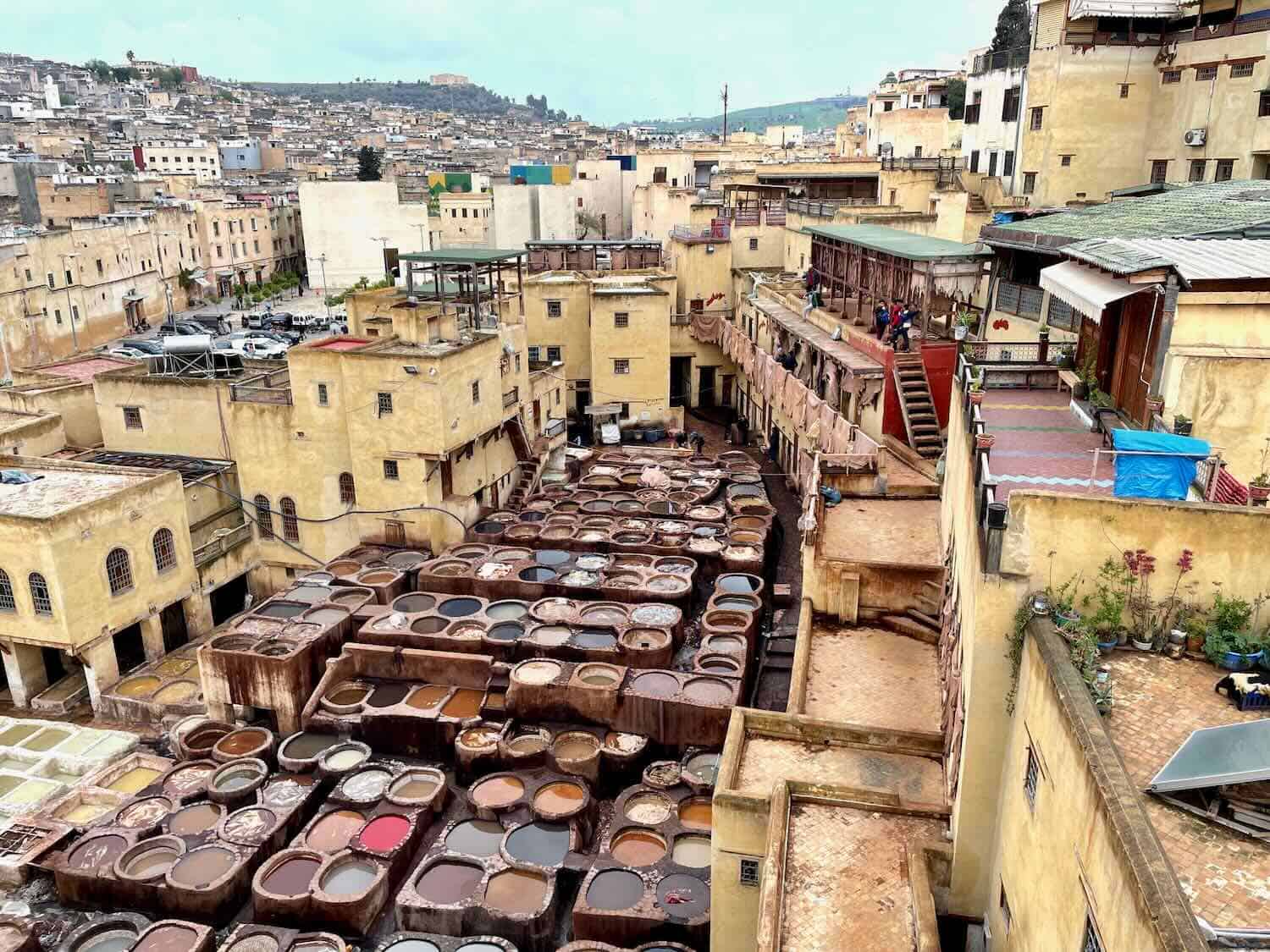
The famous tannery spans an almost medieval-looking quarter. Pick up mint sprigs upon entry to the odorous site where noxious vats soak animal hides.
Climb to the terrace to look down on the many different dye pots arranged in a honeycomb-like fashion. A salesperson will take you through a collective store selling the luxe leathery wares. Quality in Fes is unbeatable, but prices on similar items are lower in Marrakech.
The Medina of Fes
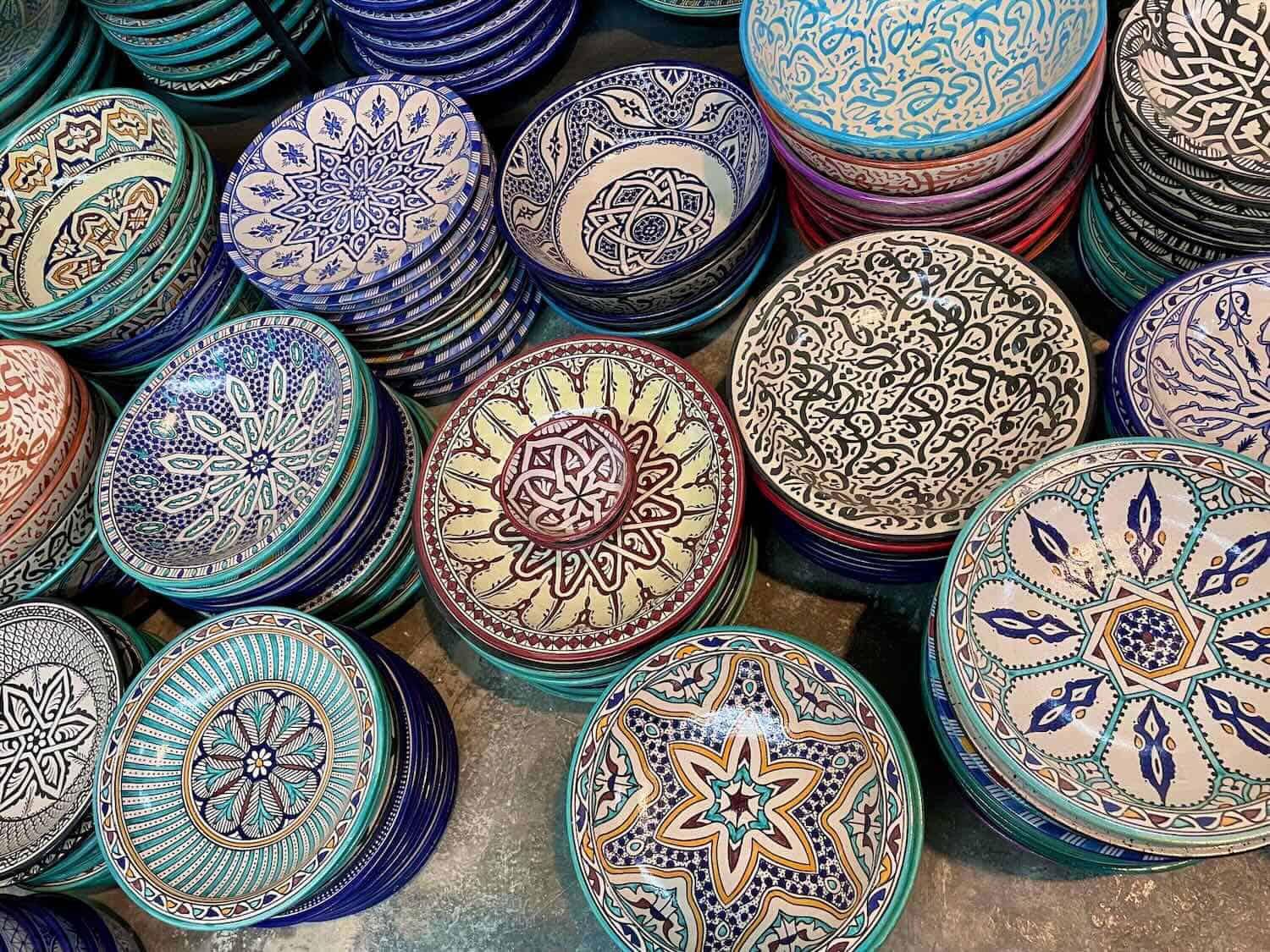
The medina of Fes includes museums, mosques, schools, and restaurants. We went inside a famous Bou Inania Medersa constructed between 1350-55.
The building acted as a school where resident students studied the Koran. Its interior courtyard displays over 650-year-old tiered tilework and complex lacy-looking stucco.
Our guide took us past the royal palace, stopping for photos of the brilliantly carved doors. We also visited the Jewish Quarter, a synagogue, and a cemetery.
The medina of Fes covers acres, so it’s necessary to take a break. It’s the perfect time to leisurely dine over a traditional meal incorporating a sensation blend of Moroccan spices. Warning: You’ll get lost in the medina without a guide. I highly recommend one.
Riads: the Fes version of boutique hotels
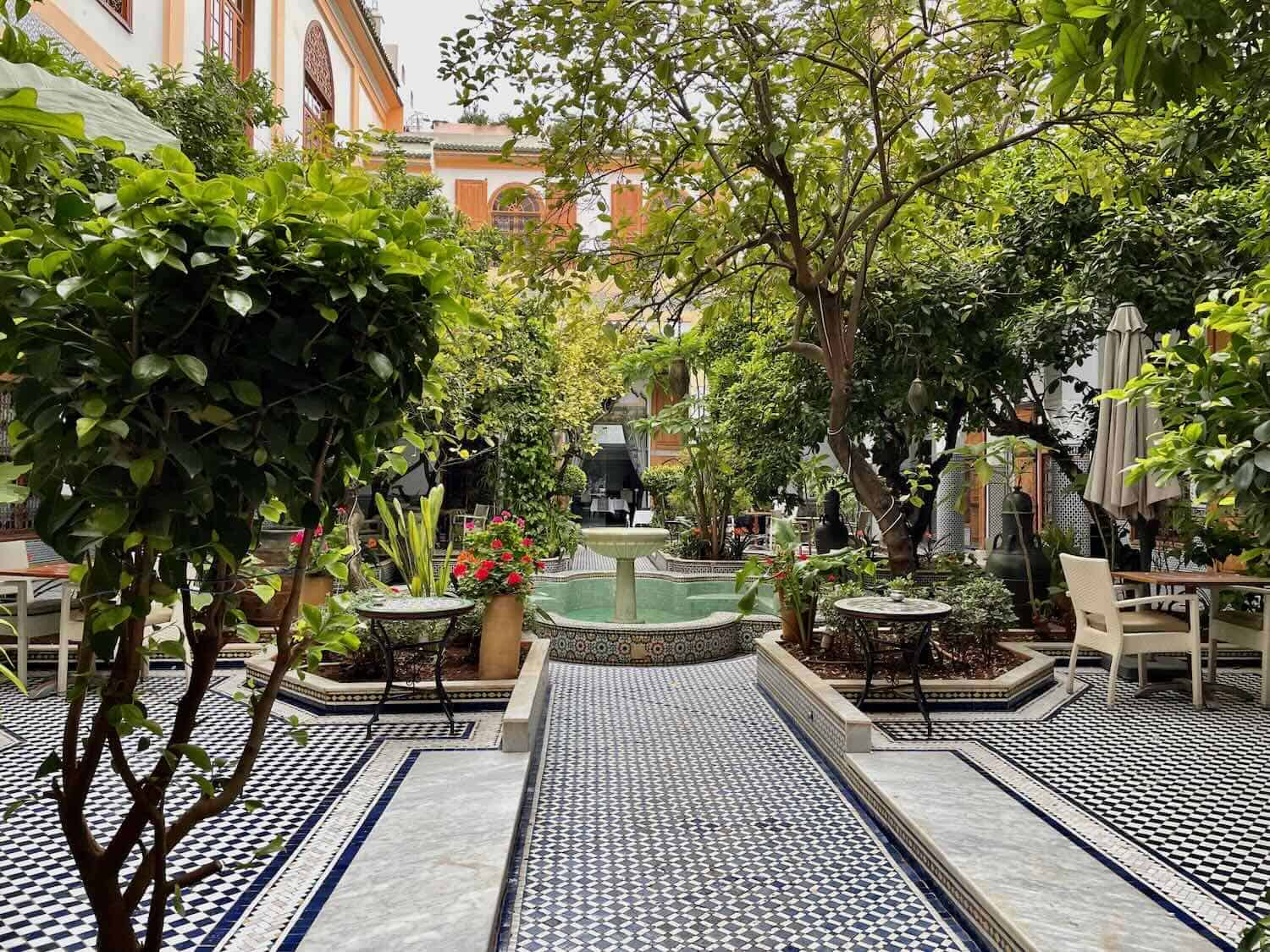
Thousands of people still live in apartments within the old medina, but many riads, former large townhomes, have been converted to boutique hotels. The exterior walls deceive; they look ordinary, just plain windowless walls.
Step inside and find a lush interior with rooms facing a central courtyard. The courtyards feature cooling pools, fountains and greenery, and rich decor in the traditional Moroccan style and architecture.
You’ll see pointed doorways, arches, and arcades with intricate plasterwork that looks like delicate lace. I recommend lodging in riads in cities throughout Morocco. In Fes, I stayed in the Riad Fes Authentic Palace.
The best of Morocco: camels and glamping in Merzouga
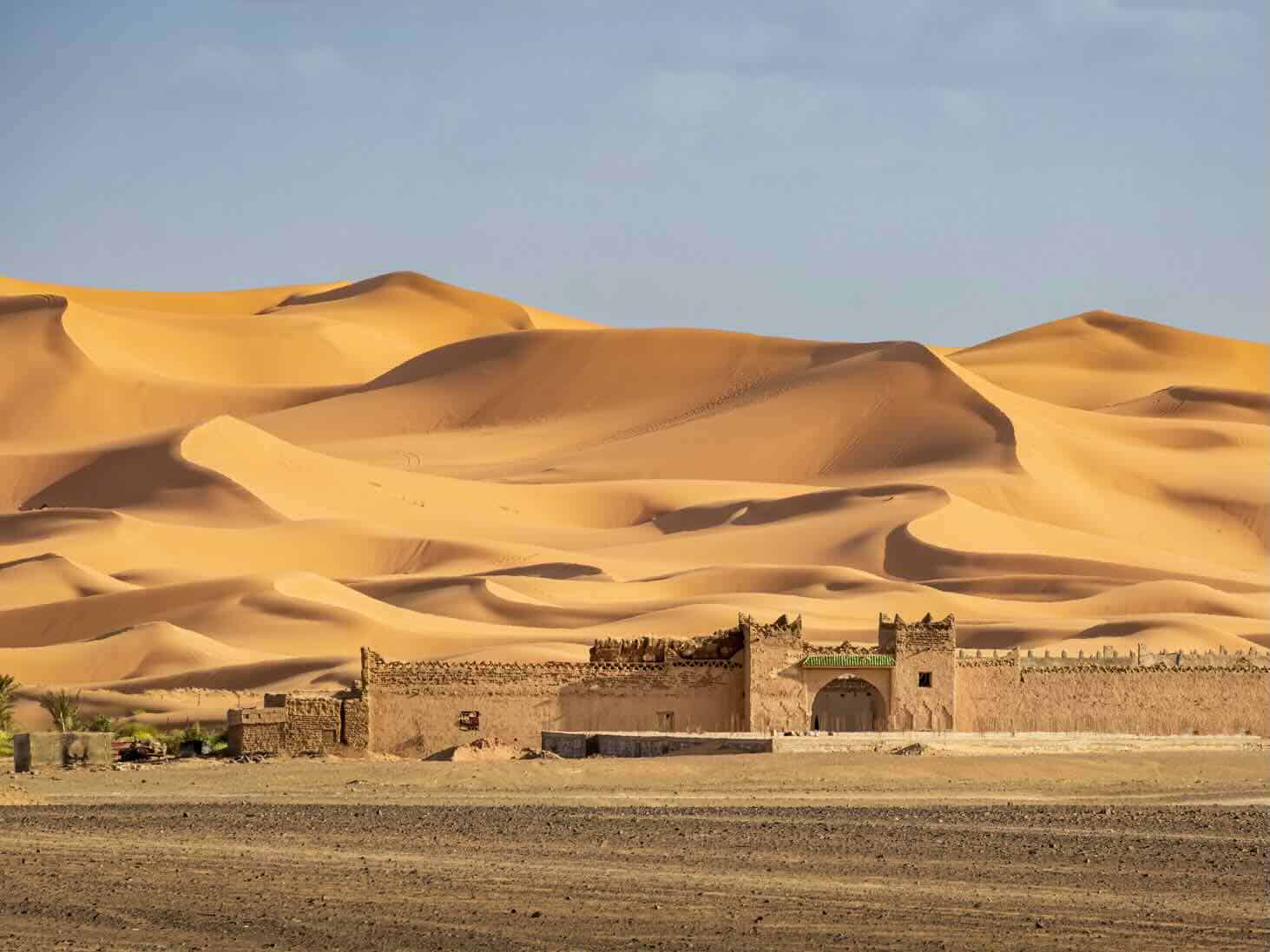
Reaching remote Merzouga from almost anywhere in Morocco involves a very long drive. But, once my van finally arrived, I knew I’d slipped into my pre-trip dream of the Sahara Desert.
I faced mountainous windswept dunes, the color of wild salmon. The dramatic shapes reflected the sun and created burning shadows in the landscape.
I pressed my eye to the camera lens, astounded by the vibrant copper color. No, not a mirage, but it felt unworldly.
Sahara Desert camel ride
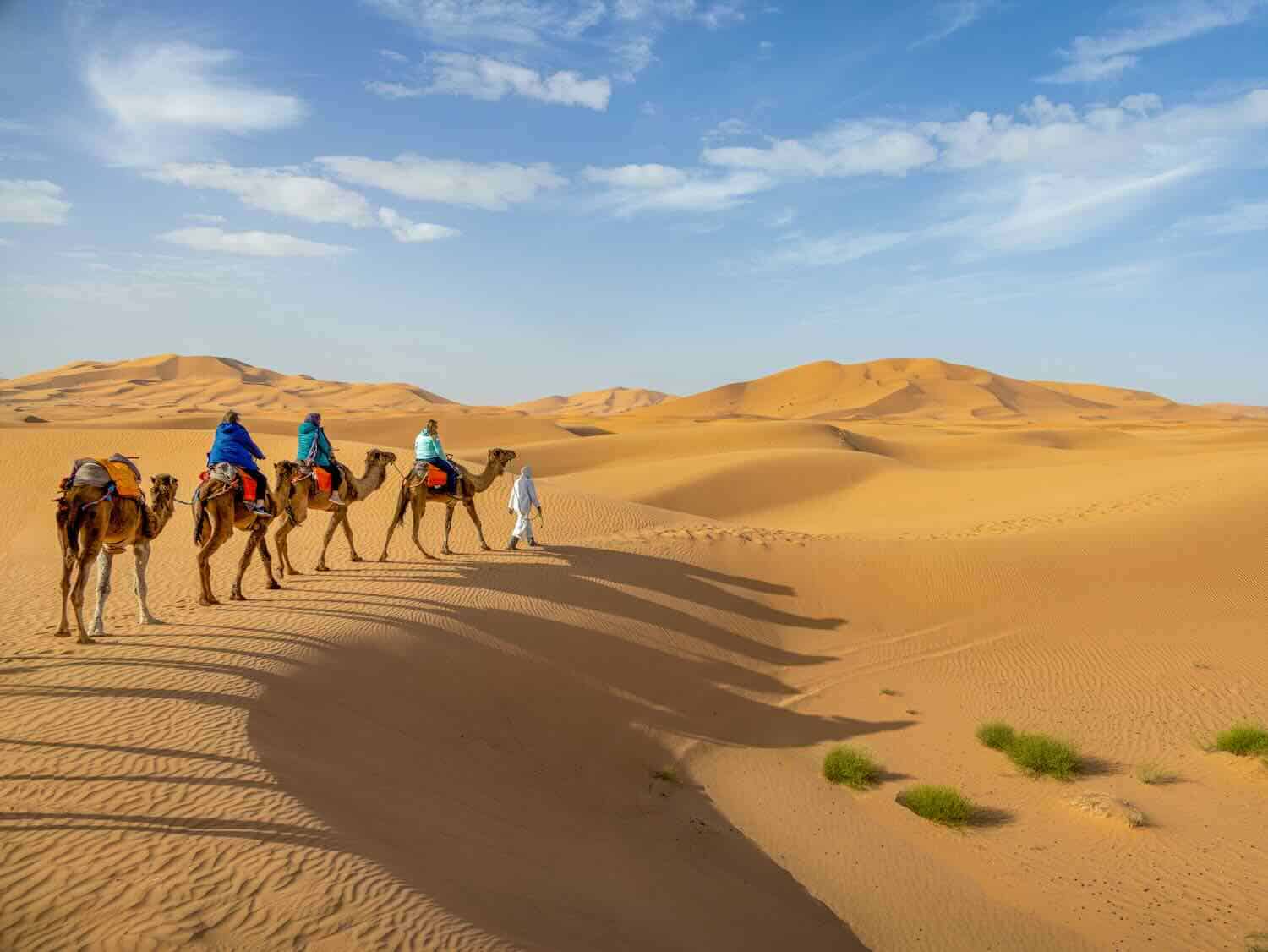
A camel ride through the dunes fulfills many a traveler’s pilgrimage. However, the first hurdle becomes the camel’s awkward and always discombobulating rise. Once my group members were mounted, we proceeded in an upward procession led by Berber guides dressed in white robes (laabaya).
The camels were tethered together in a head-to-tail fashion, so no worries that your beast will run out of line. (I have read that some camel operators don’t treat their animals well, but trust me, my American tour operator, a renowned camel rancher in Texas, would never have chosen such an enterprise.)
I found the view from saddle height, about nine feet up, quite pleasing. I tried to bask in the panoramic stretch of the splendorous desert.
I’ve ridden camels in Jordan and Egypt, but this trek felt different. The very soft sand made the camel’s cushioned feet spread with each step so that they wouldn’t sink.
When we dismounted to watch the sunset, I found the fine powdery sand made walking tiresome. I left the steep climb to the top for the younger ones, who, by the way, gave up before reaching the summit.
Though not such a stunning sunset, I savored golden hour; just being there was most memorable. We let the camels transport us to an overnight tent camp, a ride that took nearly an hour.
Sahara desert glamping
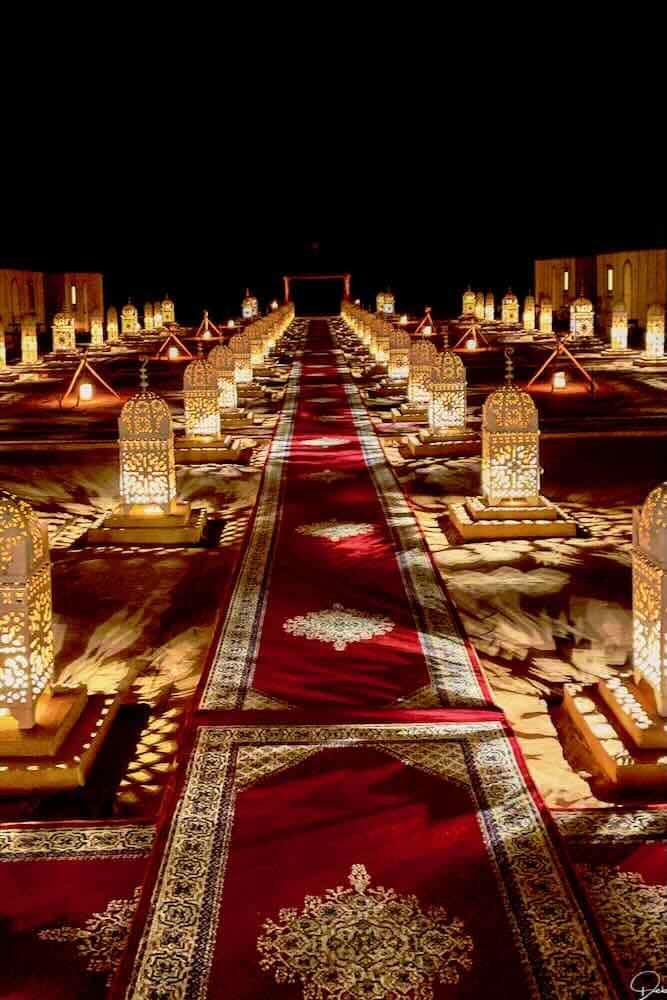
Luxury tent camping reigns supreme in this region, and I stayed in Jannat Luxury Camp, worthy of five stars. Darkness had surrounded us when we dismounted, but romantic lantern light led the way: an entire sea of pieced lanterns and Moroccan rugs.
Tired and feeling like it was midnight at the oasis — I sent my camel to bed. Well, the Berber caretakers sleep with the animals on the sand.
The resort’s dining room staff pampered us with white tablecloth service and a gourmet meal. Afterward, they played traditional music on drums, guitars, and percussion entertaining us under a clouded but star-studded sky.
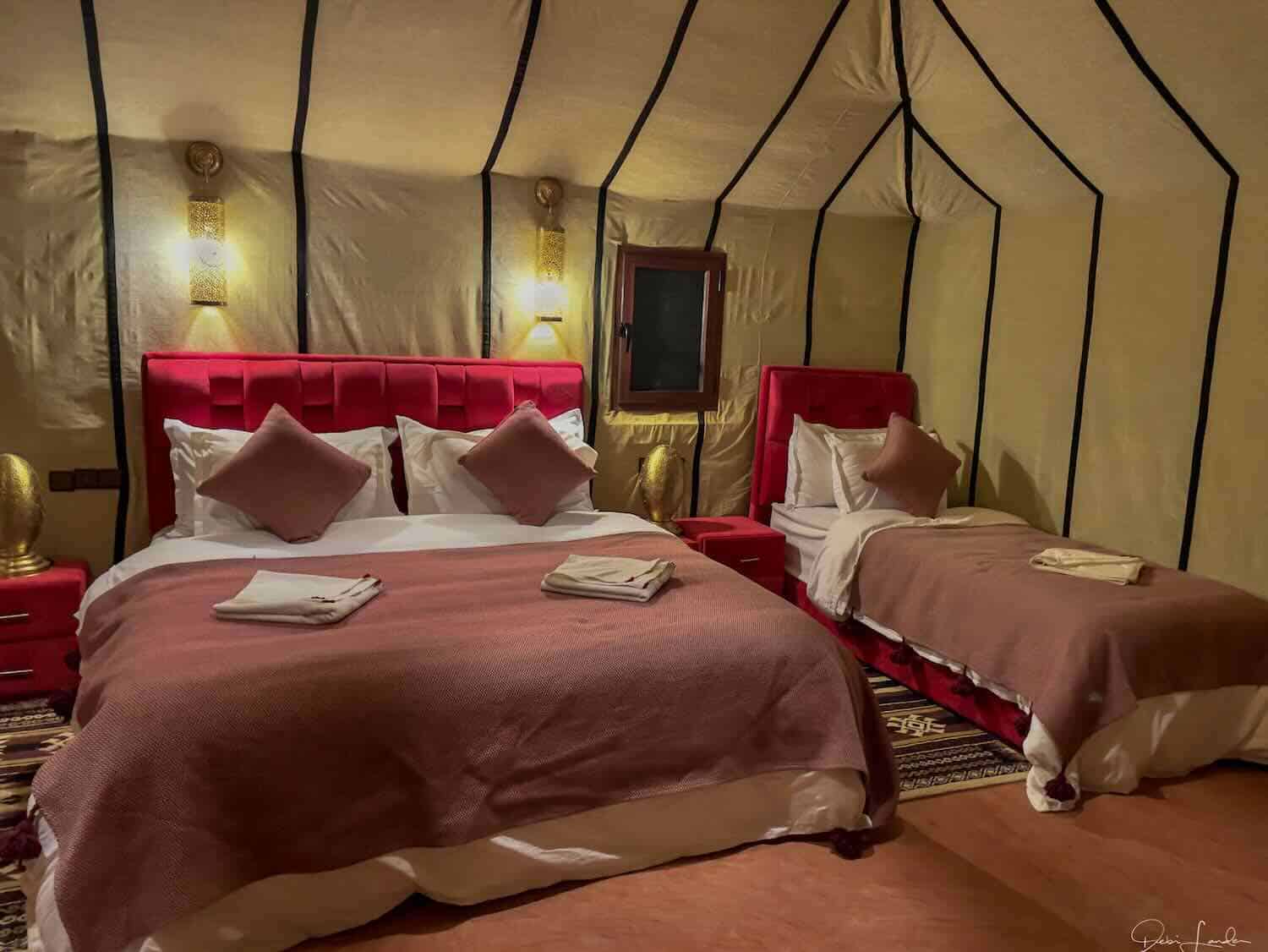
I entered my overly-large tent with one exquisite king bed and two singles dressed in fine linens. I suddenly felt like a princess in an Arabian Nights tale. I showered in a full bathroom (yes).
The spacious glamping tent boasted a gorgeously decorative sink I’d love in my home and a sitting area. Illumination within the tent came from scattered lantern-style lights.
I used an outlet to plug in my phone, yet I was in the middle of nowhere. Pinch me! I wish I could have stayed another night, but my Morocco itinerary called for me to move on.
Quarzazate: playing Hollywood in the High Atlas Mountains
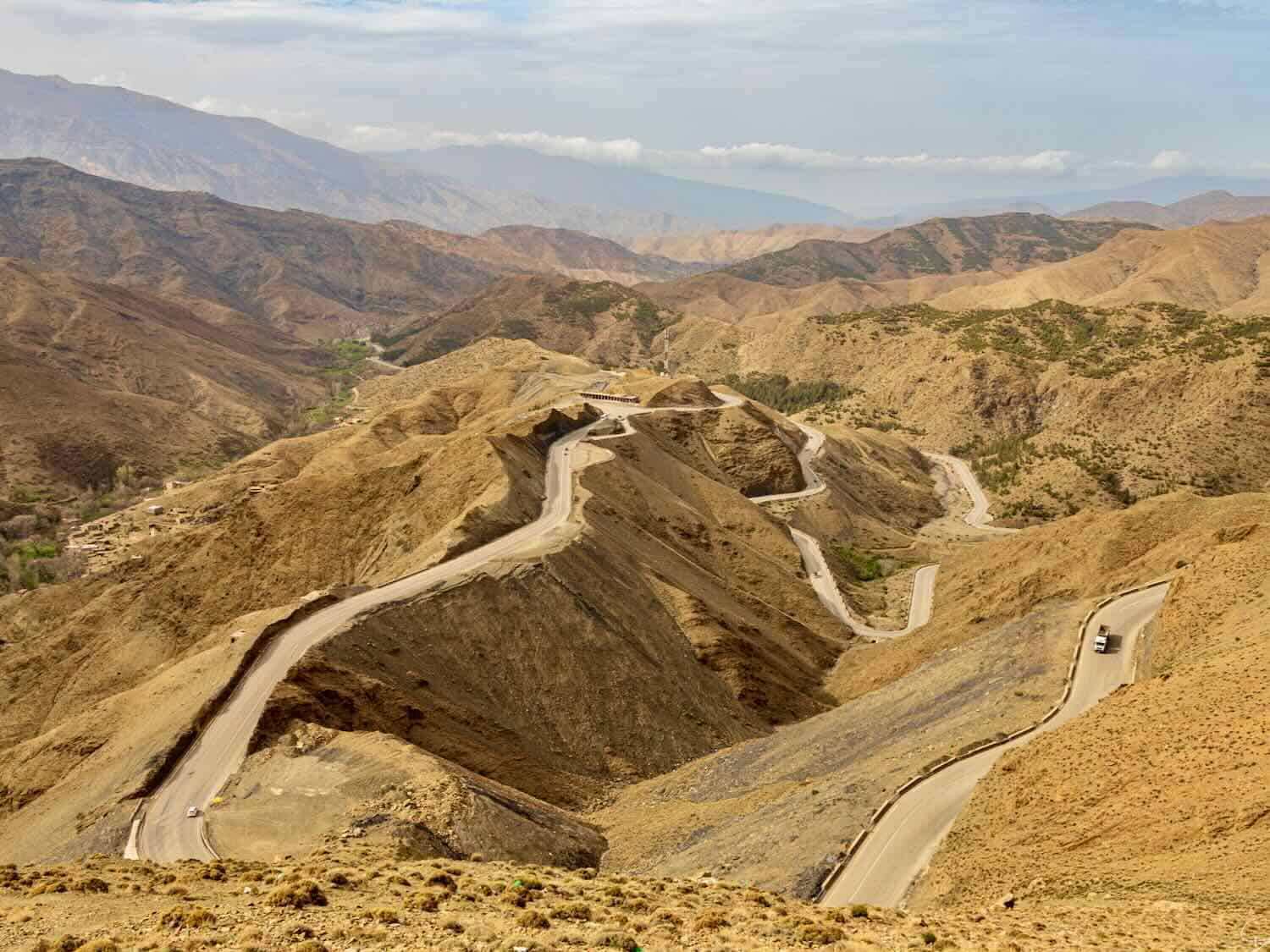
Quarzazate, our next stop, was reached by a drive along old caravan routes through the foothills and into the High Atlas Mountains. Here, Morocco flashes a powerful stance: jagged rocks, sheer cliffs, steep canyons, ravines, gorges, and crumbling terracotta kasbahs.
The van twisted and turned around four hairpin turns. Our driver snaked up the mountains on incredible serpentine roads.
I’d say the Dades Gorge Road compares to the Amalfi Drive in Italy. Car enthusiasts will be delighted, some will feel nervous.
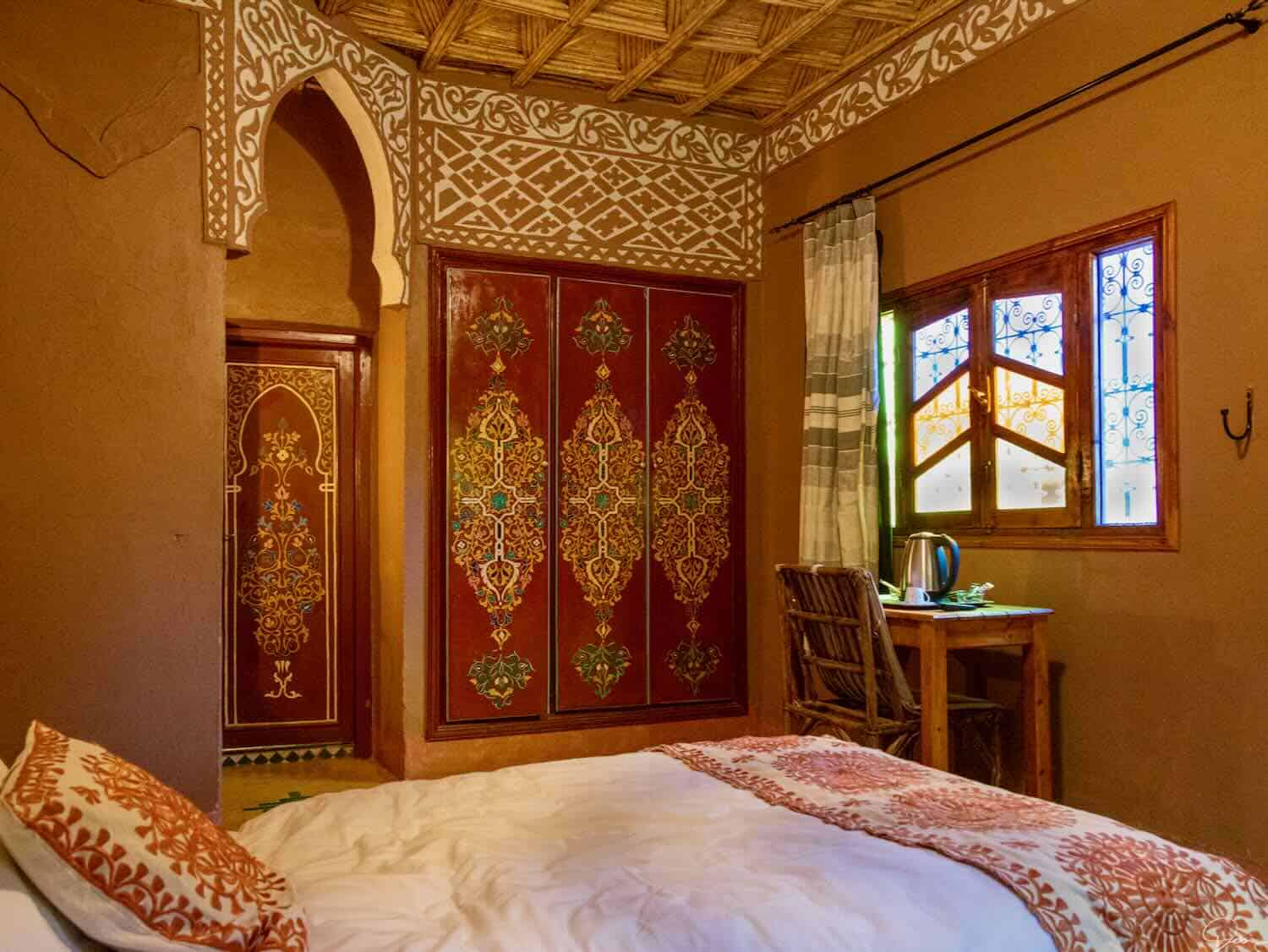
We stayed in Riad Quarzazate, a boutique hotel with the most colorful décor and opulent doors. Nearby Atlas Studios awaited a tourist attraction, sure, but a fun one.
From Lawrence of Arabia to Gladiator, many Hollywood movies, and some scenes in Games of Thrones, were filmed here. We walked around the set used by Harrison Ford, then again for the Will Smith in the movie Aladdin. Film crews captured scenes for Cleopatra and Egypt around prominent replica temples and statues.
We played tourists to the extreme as our guide set the scene, gave us parts, and then filmed my group in a brief video, sound and all. Many laughs and high-fives followed.
Marrakech: where old and new meet
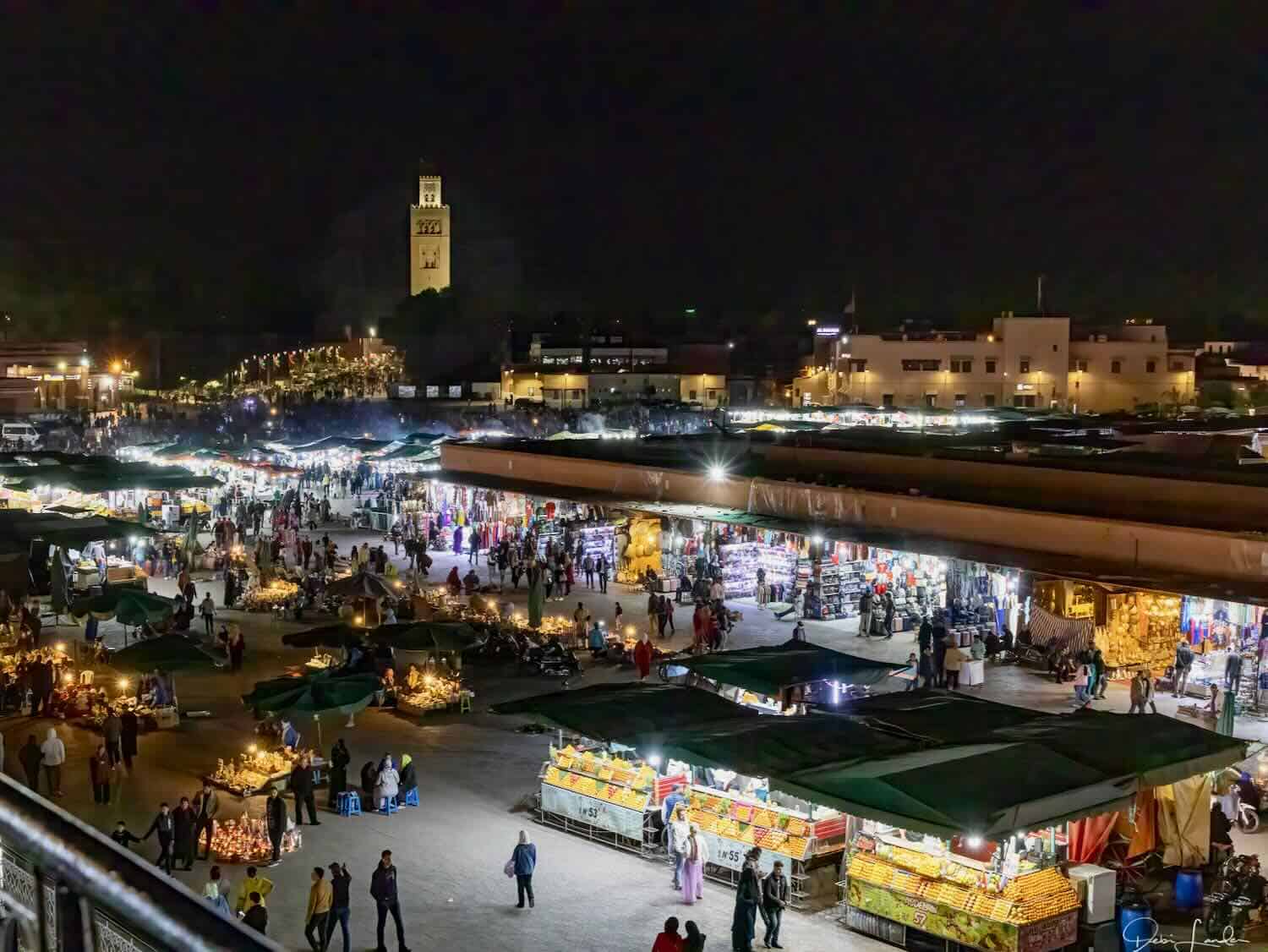
Marrakech looms as both a modern and ancient city. You’ll find hundreds of souks (shops) within the old walls with vendors hacking their wares. They like to barter.
Shopping the souks
I was reminded of Super Walmart because everything imaginable was for sale. I want to think the trinkets were Moroccan-made, but that’s not always the case. (Buy the handmade artisan products in Fes.)
In Marrakech, busy, crowded alleys eventually spill out onto the famous plaza. Exotic Jemaa el-Fna comes alive at night with street performers, snake charmers, dancing lights, and endless outdoor restaurants. I wanted to love this scene but felt underwhelmed, or maybe just tired.
Visiting Saadian Tombs and the Bahia Palais
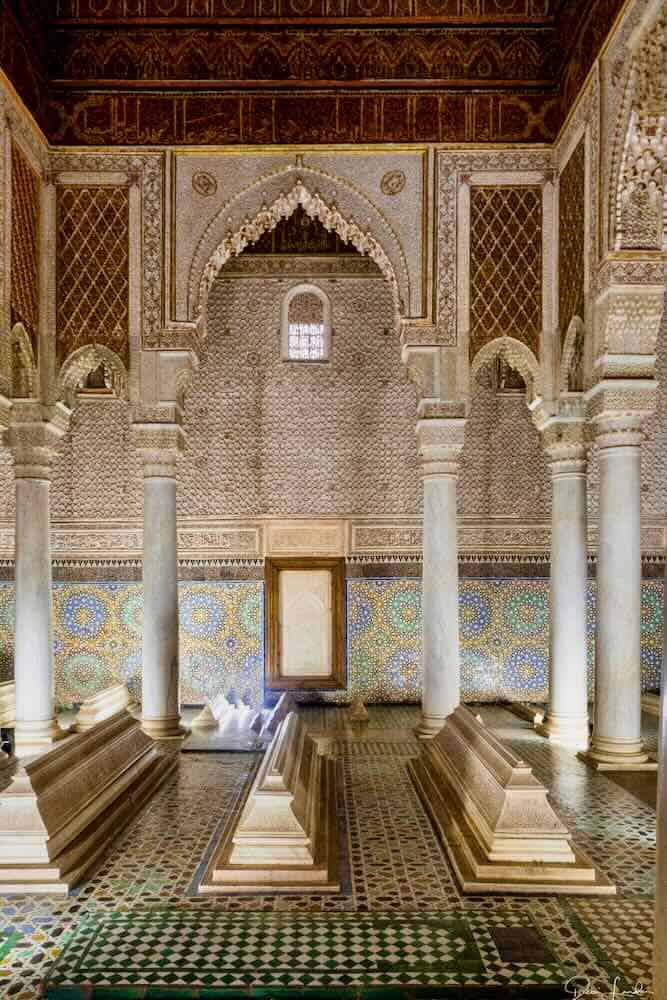
The historic royal Saadian Tombs and the Bahia Palais were more to my liking. The details on the palace ceilings, doorways, fireplaces, and courtyard align with the idea that more is not enough; even more, is better. Sadly, the rooms do not contain furniture, but the artistry and architecture are supreme examples of Moroccan flare.
Learn to cook Moroccan style
I also took a cooking class in Marrakech, learning how to make a lemon chicken tagine. We met our instructor in the market, picked out the vegetables, fruits, and herbs, then purchased chicken from the butcher (where live chickens lived in a cage at the rear ).
Our instructor and her aunt taught us. First, we sat at a long table and learned how to make and pour mint tea (the higher you raise the pot, the better). We also nibbled on some cookies ( they often eat cookies before a meal in Morocco, with fruit served at the end).
The group went to the workstations, attempting the proper techniques. My first job was to chop parsley, and auntie was very demanding that it be super fine.
We helped by cutting and peeling vegetables and pounding and arranging the ingredients. Afterward, we most thoroughly enjoyed a scrumptious feast.
Essaouria: a Moroccan beach getaway with goats in trees
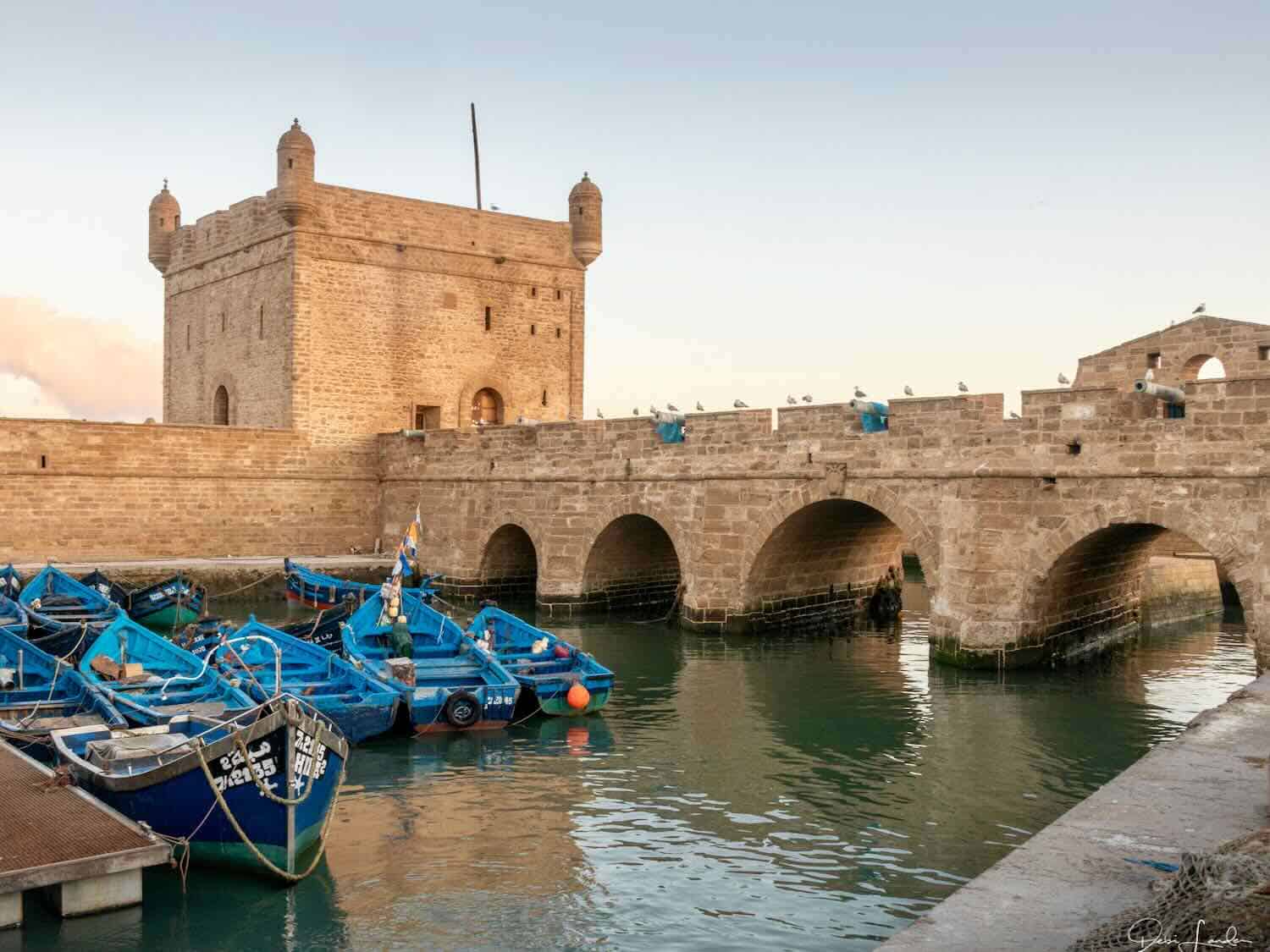
Essaouira rests at the edge of the Atlantic, a beach town hanging with surfers and stand-up paddleboarders. We watched a flaming sunset over the old port and ate street food in the ancient walled city. The next morning, I photographed the waterfront, but we needed to depart and make out way back to Casablanca for our flights home.
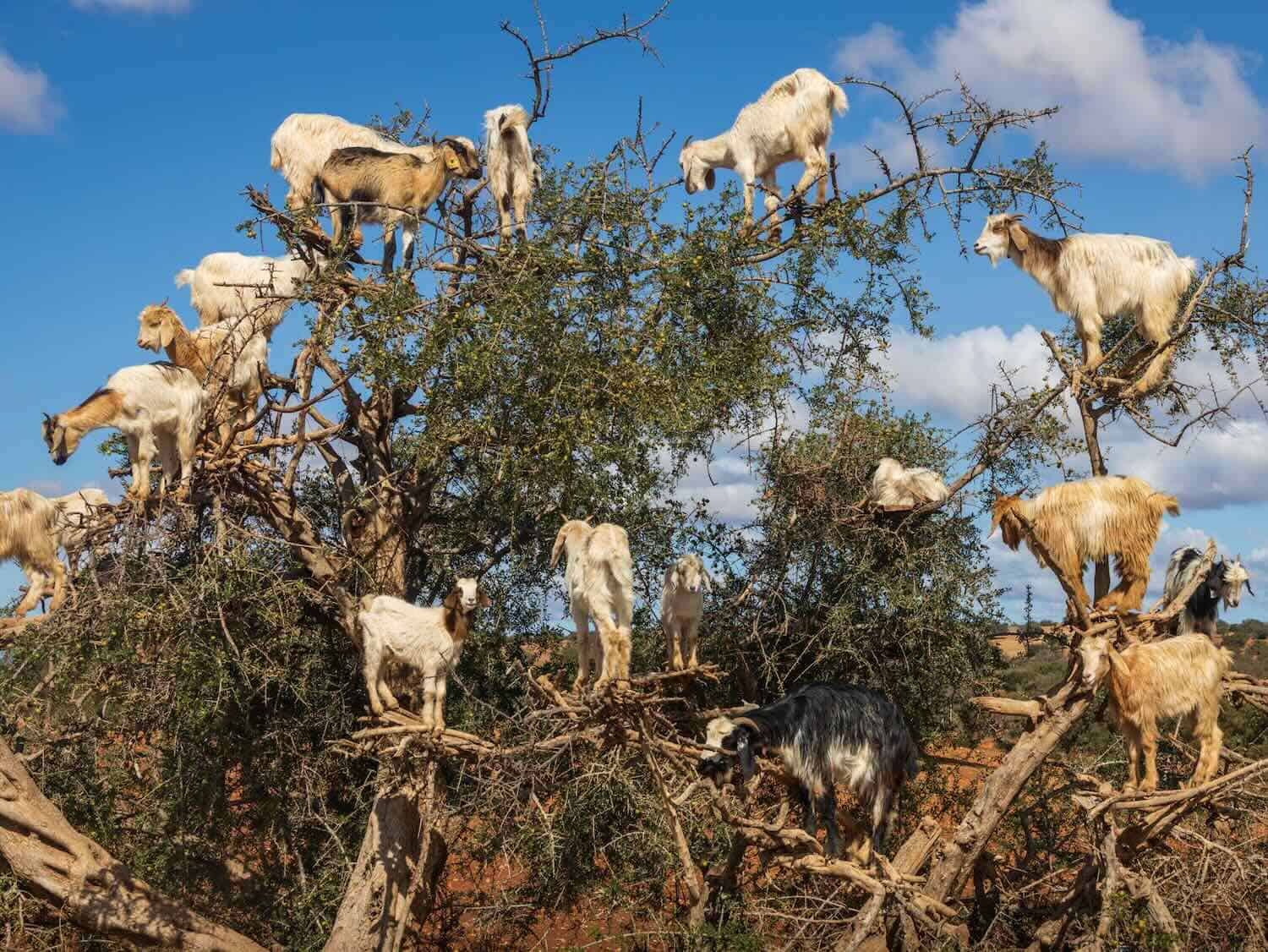
Not far out of the city, we abruptly stopped when we caught sight of a gnarled Argan tree full of goats. Argan trees grow grown exclusively in southwestern Morocco and western Algeria. The vitamin-rich oil, incorporated into special creams and lotions, is highly prized.
There’s an explanation for the strange phenomenon from National Geographic: Argan trees produce a fruit that looks like a shriveled olive and ripens each year around June. The resourceful goats crave the bitter taste and aroma, climbing up to 30 feet above ground to get their fix.
The goats eat the whole fruit, even though it’s the pulp hiding under the thick peel that tastes so good. The pulp covers a nut that humans desperately covet. So what happens next? The goats excrete the undigestible nuts, traditionally collected to make the oil.
Today, Berber women lead the time-consuming process: First, separating animal feed, then cracking open the nuts by hand for their oil-rich kernels to make expensive cosmetics or food. It takes more than 60 pounds of fruit to produce one quart of the liquid gold.
Naturally, I bought some for its anti-aging properties!
Back to Casablanca (play it again, Sam), I reflected on my two-week trip to Morocco. I’d genuinely uncovered many surprises, learned much about the culture and history, ate fabulous food, and slept in a variety of unusual rooms.
The people were welcoming and happy to see tourists. A visit to the best of Morocco is magical.

